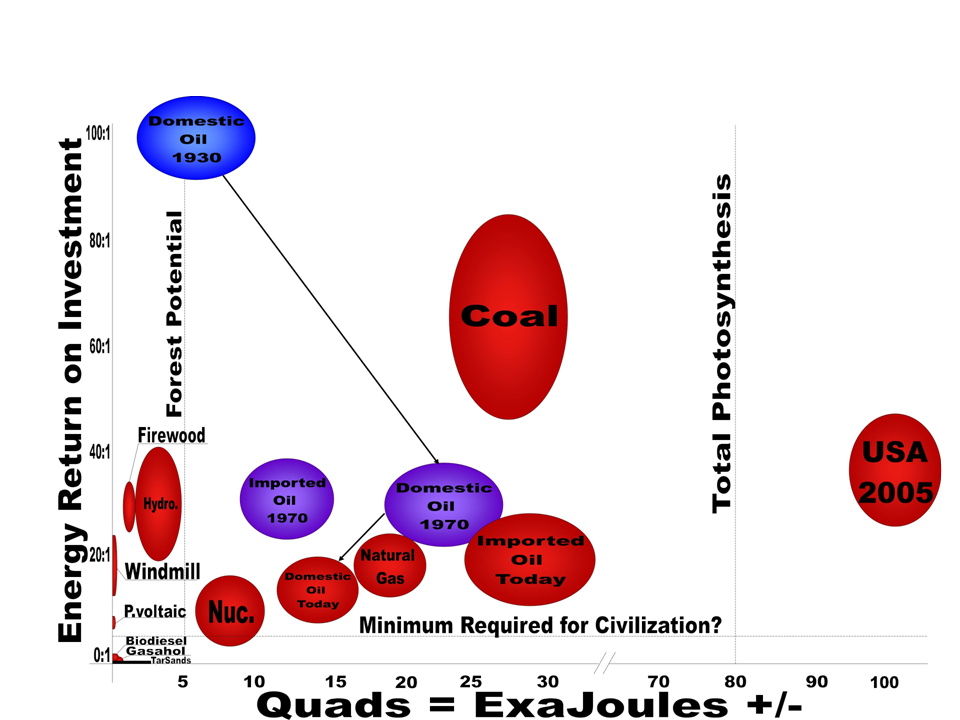Really ralfy, this level of discussion is ridiculous.
"Certainly that before the Age of Industrialization" - We are talking about the renewable energy transition, what EROI needed to be before the age of industrialization is highly irrelevant.
"I think Hall argues at least 15" - is not a good argument. Who is Hall? Why does he argue this? Especially since I think Hall doesn't argue that. Check Hall graphic below.
"Just as important is energy quantity" - I disagree, energy quantity is important, EROI is much less so. But in any case this is a deflective argument - I commented on a strong claim you made about EROI, so responding with "but energy quantity" is irrelevant.
It would be really helpful if you tried to whittle down your argument to its basics, and remove from it things that cannot be supported or that have been refuted by the responses in this thread. For example, this ridiculous 15 EROI claim.

This image shows that for 2005 Hall thinks that maybe 5:1 is the minimum for civilization. Not clear why that is the minimum, but certainly it isn't 15:1. In addition, he thinks PV solar is ~7:1, which has surely improved significantly since 2005. In addition in the text he mentions that "EROI for our major fuels (solar may be an exception) are declining over time". So in essence Hall argues solar CAN power industrial civilization.
The age prior to that of industrialization involved the use of muscle and animal power, wood for heating, wind and water mills, drying things under sunlight, etc. It was only when something better than wood was employed did it become possible to use machines and more for these tasks:
https://en.wikipedia.org/wiki/Industrial_Agethanks to additional surplus energy. That's the result of energy return.
It's that additional surplus energy which led to the use of heavy machinery in mining, mass manufacturing, and shipping across extensive supply chains to make, among other things, renewable energy components from solar panels to wind turbines available.
Thus, your claim that the energy return, what took place before and after the Age of Industrialization, etc., have nothing to do with renewable energy, is not right.
Similarly, your claim that energy quantity is irrelevant is illogical: that refers to the amount of energy available. Energy return refers to the amount available given an amount used. Obviously, with a high return, quantity also goes up, and vice versa.
"Hall" refers to Charles Hall:
https://en.wikipedia.org/wiki/Charles_A._S._HallThere are different terms employed, from biophysical economics to energy economics, but the assumptions are the same: it's energy that drives economy, and is not only the product of renewable energy components but that's needed to make the same components. That said, there is no such thing as having a positive energy return as good enough. The more you want, and the more sophisticated your wants, then the higher the energy return needed. That's why there is very little chance that the type of lifestyle you have today, which includes accessing this and other sites, could have been achieved with muscle and animal power alone.
Given that, what is the energy return needed to maintain such? According to Hall, it's better than 15:
https://www.scientificamerican.com/article/eroi-charles-hall-will-fossil-fuels-maintain-economic-growth/If you think it should be higher, then you're probably right. Just think of the difference in energy needed for someone in a Third World country who has an ecological footprint of less than two global hectares and someone in a developed one who has a footprint of four to ten. How much more energy is needed to ensure the latter? How much should the energy return be to ensure that quantity?
About the return for photovoltaic, would you be able to give the updated number? I've been asking for that since the start. The best I found was real-world data from Prieto and Hall, and as of 2017, they put it at 6:
http://energyskeptic.com/2017/tilting-at-windmills-spains-disastrous-attempt-to-replace-fossil-fuels-with-solar-pv-part-2/Now, maybe there were major upgrades during the last three years, but all I've gotten so far are prices, payback time, and nameplate power. Do you have the updated information plus your study showing that the energy return needed to maintain the current economy is higher (or lower?) than 15?
Finally, your last point doesn't follow. He's not arguing that photovoltaics can replace fossil fuels. Rather, both cannot maintain the present and future capitalist economy.
That's the same conclusion given by Sers and Victor in 2018, which I mentioned earlier.